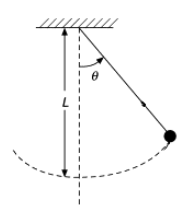
Answer
441.3k+ views
Hint: A simple pendulum is a hypothetical apparatus which consists of a point mass m suspended from a weightless, frictionless thread of constant length l and fixed at a pivotal point P. The motion of the body about the string is periodic when displaced to an initial angle of deviation from the original equilibrium position is small, representing a simple harmonic motion.

Complete step by step answer:
The information given to us:
Length of the simple pendulum,$l=50cm=0.5m$
And acceleration due to gravity, $g=9.8m/{{s}^{2}}$
The time period of a simple pendulum is given by,
$T=2\pi \sqrt{\dfrac{l}{g}}$
Where l is Length of the simple pendulum
And g is the acceleration due to gravity.
Putting the values in the formula, we get
$T=2\pi \sqrt{\dfrac{0.5}{9.8}}$
$\Rightarrow T=2\pi \sqrt{\dfrac{10}{196}}$
\[\Rightarrow T=\dfrac{2\pi }{14}\sqrt{10}\]
\[\Rightarrow T=\dfrac{\pi }{7}\sqrt{10}\]
\[\therefore T=1.419\]
Therefore, Time period of the simple pendulum, \[T=1.419\sec \]
As we know, frequency is the inverse of Time Period, thus we can find out frequency of the pendulum by
$\nu =\dfrac{1}{T}$
Putting the values, we get
$\nu =\dfrac{1}{1.419}$
\[\therefore \nu =0.745Hz\]
Therefore, frequency of the simple pendulum, \[\nu =0.745Hz\]
Hence, the correct option is option (D)\[1.419~sec\], $0.7045Hz$.
Note:
One is advised to convert quantities into their standard units as and when required just like how we have converted few into meters so as to avoid getting an incorrect answer. It is also advised to keep in mind that a simple pendulum is in equilibrium until and unless displaced to an angle, when it swings to and from extreme positions and represents a simple harmonic motion.

Complete step by step answer:
The information given to us:
Length of the simple pendulum,$l=50cm=0.5m$
And acceleration due to gravity, $g=9.8m/{{s}^{2}}$
The time period of a simple pendulum is given by,
$T=2\pi \sqrt{\dfrac{l}{g}}$
Where l is Length of the simple pendulum
And g is the acceleration due to gravity.
Putting the values in the formula, we get
$T=2\pi \sqrt{\dfrac{0.5}{9.8}}$
$\Rightarrow T=2\pi \sqrt{\dfrac{10}{196}}$
\[\Rightarrow T=\dfrac{2\pi }{14}\sqrt{10}\]
\[\Rightarrow T=\dfrac{\pi }{7}\sqrt{10}\]
\[\therefore T=1.419\]
Therefore, Time period of the simple pendulum, \[T=1.419\sec \]
As we know, frequency is the inverse of Time Period, thus we can find out frequency of the pendulum by
$\nu =\dfrac{1}{T}$
Putting the values, we get
$\nu =\dfrac{1}{1.419}$
\[\therefore \nu =0.745Hz\]
Therefore, frequency of the simple pendulum, \[\nu =0.745Hz\]
Hence, the correct option is option (D)\[1.419~sec\], $0.7045Hz$.
Note:
One is advised to convert quantities into their standard units as and when required just like how we have converted few into meters so as to avoid getting an incorrect answer. It is also advised to keep in mind that a simple pendulum is in equilibrium until and unless displaced to an angle, when it swings to and from extreme positions and represents a simple harmonic motion.
Recently Updated Pages
Who among the following was the religious guru of class 7 social science CBSE

what is the correct chronological order of the following class 10 social science CBSE

Which of the following was not the actual cause for class 10 social science CBSE

Which of the following statements is not correct A class 10 social science CBSE

Which of the following leaders was not present in the class 10 social science CBSE

Garampani Sanctuary is located at A Diphu Assam B Gangtok class 10 social science CBSE

Trending doubts
A rainbow has circular shape because A The earth is class 11 physics CBSE

Which are the Top 10 Largest Countries of the World?

Fill the blanks with the suitable prepositions 1 The class 9 english CBSE

The Equation xxx + 2 is Satisfied when x is Equal to Class 10 Maths

How do you graph the function fx 4x class 9 maths CBSE

Give 10 examples for herbs , shrubs , climbers , creepers

Who gave the slogan Jai Hind ALal Bahadur Shastri BJawaharlal class 11 social science CBSE

Difference between Prokaryotic cell and Eukaryotic class 11 biology CBSE

Why is there a time difference of about 5 hours between class 10 social science CBSE




